Sony XR-M500R User Manual
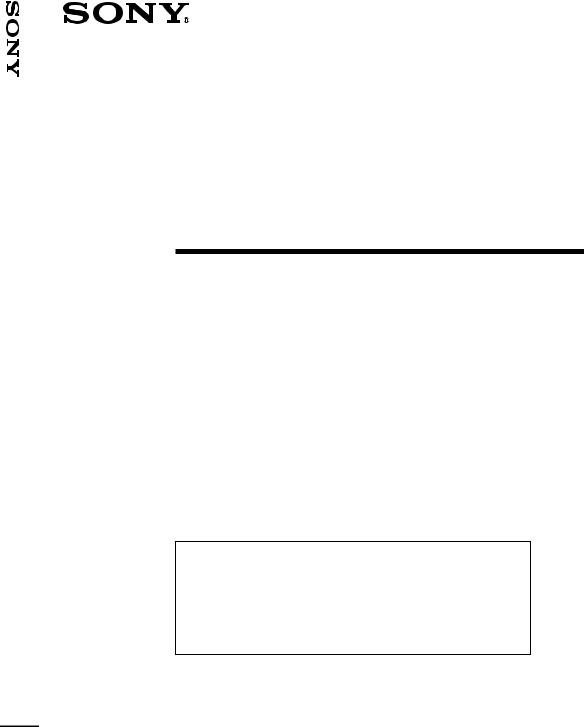
M500R-XR Stereo Car Cassette FM/MW/LW
3-047-783-11 (1)
FM/MW/LW
Cassette
Car Stereo
Operating Instructions |
GB |
|
|
|
|
Manual de instrucciones |
ES |
|
|
|
|
Bruksanvisning |
SE |
|
|
|
|
Manual de instruções |
|
PT |
For installation and connections, see the supplied installation/connections manual.
Para obtener información sobre la instalación y las conexiones, consulte el manual de instalación/conexiones suministrado.
Vi hänvisar till det medföljande häftet angående montering/anslutningar.
Para a instalação e as ligações, consulte o manual de instalação/ligações fornecido.
XR-M500R
ã 2000 Sony Corporation
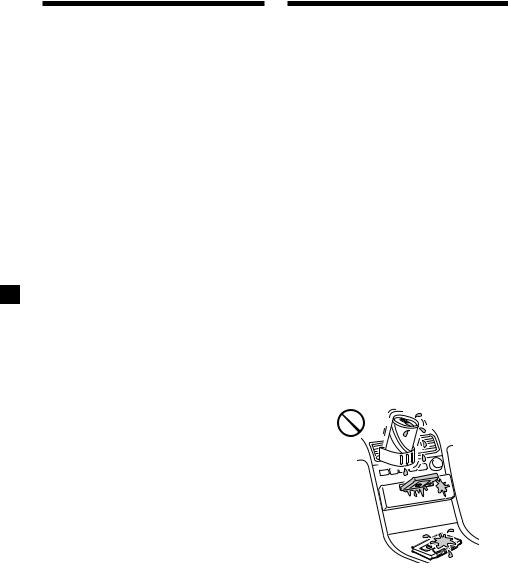
Welcome !
Thank you for purchasing this Sony Cassette Player. This unit lets you enjoy a variety of features using the following controller accessory:
Supplied accessory
Card remote commander RM-X96
Optional accessory
Rotary commander RM-X4S
In addition to the cassette playback and radio operations, you can expand your system by connecting an optional CD/MD unit*1. When you operate this unit or a connected optional CD unit with the CD TEXT function, the CD TEXT information will appear in the display when you play a CD TEXT disc*2.
*1 You can connect a CD changer, an MD changer, a CD player, or an MD player.
*2 A CD TEXT disc is an audio CD that includes information such as the disc name, artist name, and track names.
This information is recorded on the disc.
Precautions
∙If your car was parked in direct sunlight resulting in a considerable rise in temperature inside the car, allow the unit to cool off before operating it.
∙If no power is being supplied to the unit, check the connections first. If everything is in order, check the fuse.
∙If no sound comes from the speakers of a two-speaker system, set the fader control to the centre position.
∙When a tape is played back for a long period, the cassette may become warm because of the built-in power amplifier.
However, this is not a sign of malfunction.
If you have any questions or problems concerning your unit that are not covered in this manual, please consult your nearest Sony dealer.
To maintain high quality sound
If you have drink holders near your audio equipment, be careful not to splash juice or other soft drinks onto the car audio. Sugary residues on this unit or cassette tapes may contaminate the playback heads, reduce the sound quality, or prevent sound reproduction altogether.
Cassette cleaning kits cannot remove sugar from the tape heads.
2
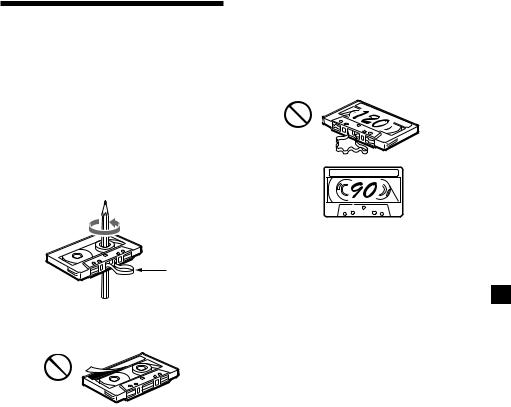
Notes on Cassettes
Cassette care
∙Do not touch the tape surface of a cassette, as any dirt or dust will contaminate the heads.
∙Keep cassettes away from equipment with built-in magnets such as speakers and amplifiers, as erasure or distortion on the recorded tape could occur.
∙Do not expose cassettes to direct sunlight, extremely cold temperatures, or moisture.
∙Slack in the tape may cause the tape to be caught in the machine. Before you insert the tape, use a pencil or similar object to turn the reel and take up any slack.
Cassettes longer than 90 minutes
The use of cassettes longer than 90 minutes is not recommended except for long continuous play. The tape used for these cassettes is very thin and tends to stretch easily. Frequent playing and stopping of these tapes may cause them to become entangled in the cassette deck mechanism.
Slack
∙Distorted cassettes and loose labels can cause problems when inserting or ejecting tapes. Remove or replace loose labels.
∙The sound may become distorted while playing the cassette. The cassette player head should be cleaned after each 50 hours of use.
3
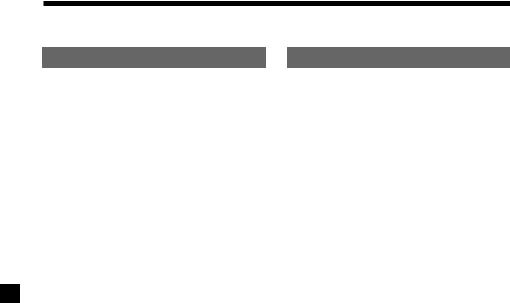
Table of Contents |
|
This Unit Only |
|
Location of controls ................................................. |
5 |
Getting Started |
|
Resetting the unit ................................................ |
8 |
Security release settings ..................................... |
8 |
Turning the unit on/off ..................................... |
9 |
How to use the menu ......................................... |
9 |
Setting the clock ................................................ |
10 |
Cassette Player |
|
Listening to a tape ............................................. |
11 |
Playing a tape in various modes ..................... |
12 |
Radio |
|
Memorising stations automatically |
|
— Best Tuning Memory (BTM) ................. |
13 |
Memorising only the desired stations ............ |
13 |
Receiving the memorised stations .................. |
14 |
RDS |
|
Overview of the RDS function ........................ |
15 |
Displaying the station name ............................ |
15 |
Retuning the same programme automatically |
|
— Alternative Frequencies (AF) ................ |
16 |
Listening to traffic announcements ................ |
17 |
Presetting the RDS stations with the AF |
|
and TA data .................................................. |
18 |
Locating a station by programme type .......... |
19 |
Setting the clock automatically ....................... |
20 |
With Optional Equipment |
|
CD/MD Unit |
|
Playing a CD or MD ......................................... |
26 |
Playing tracks repeatedly |
|
— Repeat Play .............................................. |
28 |
Playing tracks in random order |
|
— Shuffle Play .............................................. |
28 |
Labelling a CD |
|
— Disc Memo ............................................... |
29 |
Locating a disc by name |
|
— List-up ...................................................... |
30 |
Selecting specific tracks for playback |
|
— Bank .......................................................... |
31 |
DAB |
|
Overview of DAB .............................................. |
32 |
Basic operations of DAB .................................. |
32 |
Presetting DAB services automatically |
|
— BTM .......................................................... |
33 |
Presetting DAB services manually |
|
— Manual Preset Memory ......................... |
34 |
Listening to a DAB programme ...................... |
35 |
Settings on the audio reception ....................... |
36 |
Locating a DAB service by programme type |
|
(PTY) .............................................................. |
36 |
Other Functions |
|
Labelling the rotary commander .................... |
20 |
Using the rotary commander .......................... |
21 |
Adjusting the sound characteristics ............... |
23 |
Attenuating the sound ..................................... |
23 |
Changing the sound and display settings ..... |
23 |
Boosting the bass sound |
|
— D-bass ....................................................... |
24 |
Selecting the spectrum analyser ..................... |
25 |
Adjusting the sound and frequency of the |
|
equalizer preamplifier ................................. |
25 |
Additional Information |
|
Maintenance ....................................................... |
37 |
Dismounting the unit ....................................... |
38 |
Specifications ..................................................... |
39 |
Troubleshooting guide ..................................... |
40 |
4
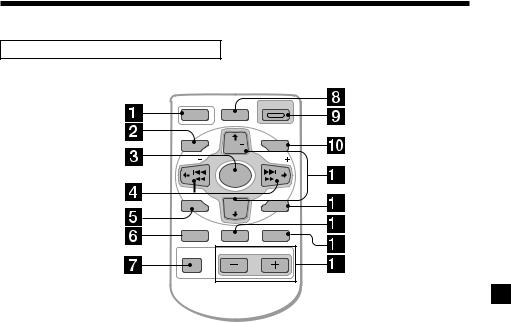
Location of controls
Card remote commander RM-X96
|
|
OPEN/CLOSE |
OFF |
D-BASS |
|
MENU |
DISC |
LIST |
SEEK |
|
SEEK |
SOURCE
SOUND DISC ENTER
ENTER
 PTY
PTY
 DSPL AF/TA MODE
DSPL AF/TA MODE
ATT |
VOL |
Refer to the pages listed for details.
1 OFF button 9, 11
2MENU button 10, 12, 13, 14, 16, 18, 20, 24, 25, 27, 28, 29, 31, 33, 34, 36
3SOURCE (TUNER/TAPE/CD/MD) button 9, 11, 13, 14, 25, 26, 30, 32, 33
4</, (SEEK/AMS –/+) buttons
9, 10, 11, 12, 14, 16, 20, 23, 24, 25, 27, 28, 29, 31, 32, 34, 36
Automatic Music Sensor (./>) 11, 27
Manual search (m/M) 27 Seek 14
5 SOUND button 23
6DSPL/PTY (display mode change/ programme type) button
19, 26, 27, 29, 36
7 ATT (attenuate) button 23
8 D-BASS button 24
9 OPEN/CLOSE button 11
0 LIST button 29, 30, 35
qa M/m (DISC/PRST +/–) buttons
9, 10, 12, 13, 14, 16, 18, 19, 20, 24, 25, 27, 28, 29, 30, 31, 32, 33, 34, 36 During radio reception:
Preset stations select 14 During CD/MD playback:
Disc change 27
qs ENTER button 10, 12, 13, 14, 16, 18, 19, 20, 24, 25, 27, 29, 30, 31, 33, 34, 35, 36
qd AF/TA button 16, 17, 18
qf MODE button
11, 12, 13, 14, 26, 30, 32, 33 During tape playback:
Playback direction change 11 During radio reception:
BAND select 13, 14 During CD/MD playback: CD/MD unit select 26
qg VOL (Volume adjust) buttons
A unit turned off by pressing (OFF) for two seconds cannot be operated with the card remote commander unless (SOURCE) on the unit is pressed or a cassette is inserted to activate the unit first.
5
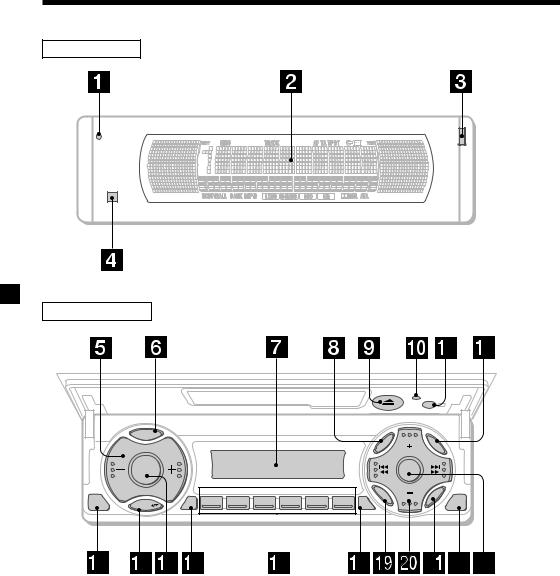
Location of controls
Security side
Operation side
PTY
DSPL
SOURCE
MENU
DISC
D-BASS
LIST
OFF
M
O
DE
|
REP |
SHUF |
|
|
|
|
SOUND |
|
AF |
1 |
2 |
3 |
4 |
5 |
6 |
||
TA |
XR-M500R
DISC
ENTER
CLOSE
6

The corresponding buttons of the unit control the same functions as those on the card remote commander.
10 Reset button 8
2 Main display window
3 OPEN button 38
4qa Receptor for the card remote commander
5 Volume adjust buttons
6DSPL/PTY (display mode change/ programme type) button
7 Sub display window
8 MENU button
9 Z (eject) button 11 qs LIST button
qd OFF button* 9 qf MODE button
qg SOURCE (TUNER/TAPE/CD/MD) button qh AF button 16, 18
qj Number buttons During radio reception:
Preset number select 13, 14, 17, 33, 34
During tape playback:
(1) REP 12
During CD/MD playback:
(1)REP 28
(2)SHUF 28
qk TA button 16, 17, 18 ql SOUND button
w; PRST/DISC +/– (cursor up/down) buttons SEEK/AMS –/+ (cursor left/right) buttons 13
wa ENTER button ws CLOSE button wd D-BASS button
*Warning when installing in a car without ACC (accessory) position on the ignition key switch
Be sure to press (OFF) on the unit for two seconds to turn off the clock display after turning off the engine.
When you press (OFF) only momentarily, the clock display does not turn off and this causes battery wear.
7
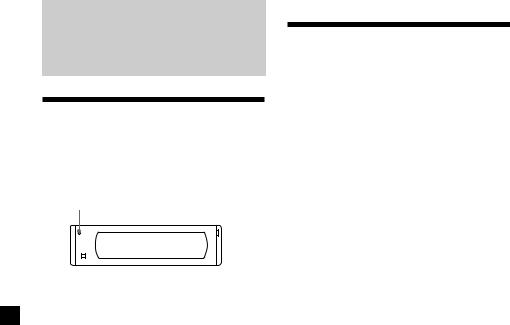
Getting Started
Resetting the unit
Before operating the unit for the first time or after replacing the car battery, you must reset the unit.
Press the reset button with a pointed object, such as a ballpoint pen.
Reset button
Note
Pressing the reset button will erase the clock setting and some memorised functions.
Security release settings
Do the following initial settings before you operate the unit for the first time, after replacing the car battery, or after resetting the unit.
Be sure to make these settings, otherwise the front panel remains disabled and you will be unable to operate the unit.
1 Press the reset button.
“Code in” appears.
2 Press the buttons on the card remote commander, and send the security code.
Please refer to the supplied insert for details on the security code buttons.
When the code has been confirmed, the display changes to clock, and you can operate the unit normally.
Notes
•When you leave the car, take the card remote control with you.
•If you forget the security code, consult your Sony Service Centre. Be sure to bring the card remote control with you.
8
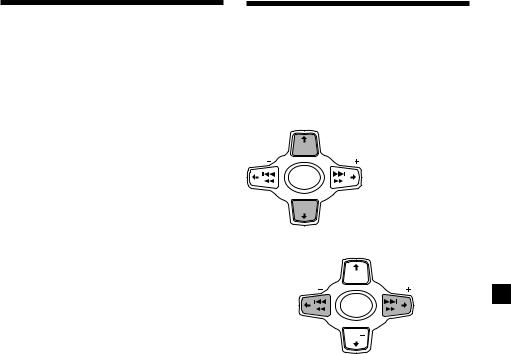
Turning the unit on/off
Turning on the unit
Press (SOURCE) or insert a cassette in the unit. For details on operation, refer to page 11 (cassette player) and page 13 (radio).
Turning off the unit
Press (OFF) to stop tape playback or FM/ MW/LW reception (the key illumination and display remains on).
Press (OFF) for two seconds to completely turn off the unit.
Note
If your car has no ACC position on the ignition key switch, be sure to turn the unit off by pressing (OFF) for two seconds to avoid car battery wear.
How to use the menu
This unit is operated by selecting items from a menu.
To select, first enter the menu mode and choose M/m (up/down), or choose </, (left/right).
M/m
M : To select upwards
DISC
SEEK |
SEEK |
SOURCE
DISC
m : To select downwards
</,
DISC
SEEK |
|
SEEK |
< : |
SOURCE |
, : |
To select |
To select |
|
leftwards |
|
rightwards |
|
DISC |
|
9
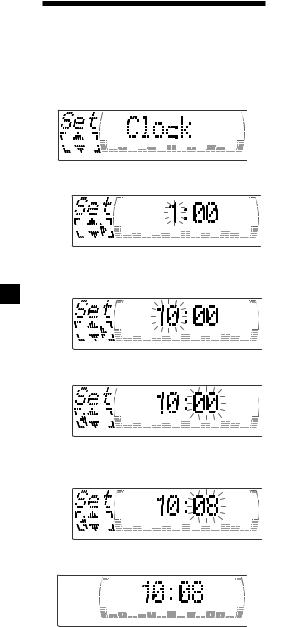
Setting the clock
The clock uses a 24-hour digital indication.
Example: To set the clock to 10:08
1 Press (MENU), then M or m repeatedly until “Clock” appears.
1 Press (ENTER).
The hour indication flashes.
2 Press M or m to set the hour.
3 Press ,.
The minute indication flashes.
4 Press M or m to set the minute.
2 Press (ENTER).
The clock starts.
Tips
•You can use the convenient CT function to set the clock automatically (page 20).
•When the D.Info mode is set to “on,” the time is always displayed (except for some functions of SA mode) (page 23).
10

Cassette Player
Listening to a tape
1 Press (OPEN/CLOSE) of the card remote commander and insert a cassette.
Playback starts automatically.
2 Press (OPEN/CLOSE) of the card remote commander to close the front panel.
If a cassette is already inserted, to start playback, press (SOURCE) repeatedly until “FWD” or “REV” appears.
The side facing up is played.
The side facing down is played.
Tip
To change the tape‘s playback direction, press
(MODE) (o).
To |
Press |
Stop playback |
(OFF) |
Eject the cassette |
(OPEN/CLOSE) then Z |
|
|
Fast-winding the tape
During playback, press and hold m or M.
|
|
DISC |
|
m : |
SEEK |
SOURCE |
SEEK M : |
Rewind |
|
Fast-forward |
|
|
|
||
|
|
DISC |
|
To start playback during fast-forwarding or rewinding, press (MODE) (o).
Locating a specific track
—Automatic Music Sensor (AMS)
During playback, press . or > momentarily for each track you want to skip.
You can skip up to nine tracks at one time.
. : |
|
DISC |
SEEK > : |
SEEK |
|
||
To locate |
|
SOURCE |
To locate |
preceding |
|
succeeding |
|
|
|
||
tracks |
|
DISC |
tracks |
|
|
|
Note
The AMS function may not work when:
—the blanks between tracks are shorter than four seconds
—there is noise between tracks
—there are long sections of low volume or quiet sections.
In the Motion Display mode, all the items are scrolled in the display one by one in order.
Tip
The Motion Display mode can be turned off. (See “Changing the sound and display settings” on page 23.)
11

Playing a tape in various modes
You can play the tape in various modes: •Repeat (Repeat Play) repeats the current
track.
•NR (Dolby NR) lets you select the Dolby* NR B system.
•Metal lets you play a metal or CrO2 tape. •B.Skip (Blank Skip) skips blanks longer than
eight seconds.
•ATA (Automatic Tuner Activation) turns on the tuner automatically when fast-winding the tape.
*Dolby noise reduction manufactured under license from Dolby Laboratories.
”DOLBY“ and the double-D symbol are trademarks of Dolby Laboratories.
1 During playback, press (MENU).
2 Press M or m repeatedly until the desired item appears.
Each time you press m, the item changes as follows:
Repeat t NR t Metal t B.Skip t ATA
3 Press , to select “on.”
Playing tracks repeatedly
— Repeat Play
1 During playback, press (MENU).
2 Press M or m repeatedly until “Repeat” appears.
3 Press , repeatedly until “Repeat on” in the display appears.
Repeat on y Repeat off
Repeat Play starts.
To return to normal playback mode, select “Repeat off” in step 3.
Tips
•If you select the mode using the buttons on the unit, press (1) (REP) repeatedly until the desired mode appears.
•During repeat playback, press (MODE). “REP” disappears from the display and repeat mode is cancelled.
Play mode starts.
4 Press (ENTER).
To return to normal playback mode, select “off” in step 3.
Tip
While the ATA function is activated, the display (TAPE y TUNER) can be changed by pressing
(DSPL/PTY).
12

Radio
Memorising stations automatically
— Best Tuning Memory (BTM)
The unit selects the stations with the strongest signals and memorises them in the order of their frequencies. You can store up to 6 stations on each band (FM1, FM2, FM3, MW, and LW).
Caution
When tuning in stations while driving, use Best Tuning Memory to prevent accidents.
1 Press (SOURCE) repeatedly to select the tuner.
Each time you press (SOURCE), the source changes as follows:
 B Tuner B CD* B MD* B TAPE
B Tuner B CD* B MD* B TAPE 
*If the corresponding optional equipment is not connected, this item will not appear.
2 Press (MODE) repeatedly to select the band.
Each time you press (MODE), the band changes as follows:
B FM1 B FM2 B FM3 B MW B LW 
3 Press (MENU), then press M or m repeatedly until “BTM” appears.
4 Press (ENTER).
The unit stores stations in the order of their frequencies on the number buttons.
A beep sounds when the setting is stored.
Notes
•The unit does not store stations with weak signals. If only a few stations can be received, some number buttons will retain their former setting.
•When a number is indicated in the display, the unit starts storing stations from the one currently displayed.
Memorising only the desired stations
You can preset up to 18 FM stations (6 each for FM1, 2, and 3), up to 6 MW stations, and up to 6 LW stations in the order of your choice.
1 Press (SOURCE) repeatedly to select the tuner.
2 Press (MODE) repeatedly to select the band.
3 Press . or > of the unit to tune in the station that you want to store on the number button.
4 Press the desired number button ((1) to
(6)) of the unit until “MEM” appears.
The number button indication appears in the display.
Note
If you try to store another station on the same number button, the previously stored station will be erased.
13

Receiving the memorised stations
1 Press (SOURCE) repeatedly to select the tuner.
2 Press (MODE) repeatedly to select the band.
3 Press M (preset up) or m (preset down) repeatedly to receive the stations in the order they are stored in the memory.
Tip
If you memorising the station using the buttons on the unit, press the number button ((1) to (6)) on which the desired station is stored.
If you cannot tune in a preset station
Press < or , to search for the station (automatic tuning).
Scanning stops when the unit receives a station. Press < or , repeatedly until the desired station is received.
Note
If the automatic tuning stops too frequently, press (MENU), then press M or m repeatedly until “Local” (local seek mode) is displayed. Then press , to select “Local on.” Press (ENTER).
During local reception and station selection, “LCL Seek” appears in the display.
Only the stations with relatively strong signals will be tuned in.
Tip
If you know the frequency of the station you want to listen to, press and hold < or , until the desired frequency appears (manual tuning).
If FM stereo reception is poor
— Monaural Mode
1 During radio reception, press (MENU), then press M or m repeatedly until “Mono” appears.
2 Press , until “Mono on“ appears.
The sound improves, but becomes monaural (“ST” disappears).
3 Press (ENTER).
To return to normal mode, select “Mono off” in step 2.
In the Motion Display mode, all the items are scrolled in the display one by one in order.
Tip
The Motion Display mode can be turned off. (See “Changing the sound and display settings” on page 23.)
14

RDS
Overview of the RDS function
Radio Data System (RDS) is a broadcasting service that allows FM stations to send additional digital information along with the regular radio programme signal. Your car stereo offers you a variety of services. Here are just a few: retuning the same programme automatically, listening to traffic announcements, and locating a station by programme type.
Notes
•Depending on the country or region, not all of the RDS functions are available.
•RDS may not work properly if the signal strength is weak or if the station you are tuned to is not transmitting RDS data.
Displaying the station name
The name of the current station lights up in the display.
Select an FM station (page 13).
When you tune in an FM station that transmits RDS data, the station name appears in the display.
In the Motion Display mode, all the items are scrolled in the display one by one in order.
Tip
The Motion Display mode can be turned off. (See “Changing the sound and display settings” on page 23.)
Note
The “*” indication means that an RDS station is being received.
15

Retuning the same programme automatically
— Alternative Frequencies (AF)
The Alternative Frequencies (AF) function automatically selects and retunes the station with the strongest signal in a network. By using this function, you can continuously listen to the same programme during a longdistance drive without having to retune the station manually.
Frequencies change automatically.
98.5MHz |
96.0MHz |
Station |
102.5MHz
1 Select an FM station (page 13).
2 Press (AF/TA) repeatedly until “AF on” appears.
The unit starts searching for an alternative station with a stronger signal in the same network.
Tip
If you select the mode using the buttons on the unit, press (AF) until “AF on” appears.
Changing the display item
Each time you press (AF/TA), the item changes as follows:
B AF on |
B TA on |
B AF TA on* |
AF TA off b
*Select this to turn on both the AF and TA functions.
Tips
•Each time you press (AF) on the unit, the item changes as follows:
AF on y AF off
•Each time you press (TA) on the unit, the item changes as follows:
TA on y TA off
Notes
•When there is no alternative station in the area and you do not need to search for an alternative station, turn the AF function off by pressing (AF/TA) repeatedly until “AF TA off” appears.
•When “NO AF” and the station name flash alternately, it means that the unit cannot find an alternative station in the network.
•If the station name starts flashing after selecting a station with the AF function on, this indicates that no alternative frequency is available. Press < or , while the station name is flashing (within eight seconds). The unit starts searching for another frequency with the same PI (Programme Identification) data (“PI Seek” appears and no sound is heard). If the unit cannot find another frequency, “NO PI” appears, and the unit returns to the previously selected frequency.
Listening to a regional programme
The “REG on” (regional on) function lets you stay tuned to a regional programme without being switched to another regional station.
(Note that you must turn the AF function on.) The unit is factory preset to “REG on,” but if you want to turn off the function, do the following.
1 During radio reception, press (MENU), then press M or m repeatedly until “REG” appears.
2 Press , until “REG off” appears.
3 Press (ENTER).
Note that selecting “REG off” might cause the unit to switch to another regional station within the same network.
To return to regional on, select “REG on” in step 2.
|
Note |
|
16 |
This function does not work in the United |
|
Kingdom and in some other areas. |
||
|

Local link function (United Kingdom only)
The Local Link function lets you select other local stations in the area, even if they are not stored on your number buttons.
1 Press a number button of the unit that has a local station stored on it.
2 Within five seconds, press the number button of the local station again.
3 Repeat this procedure until the desired local station is received.
Listening to traffic announcements
The Traffic Announcement (TA) and Traffic Programme (TP) data let you automatically tune in an FM station that is broadcasting traffic announcements even if you are listening to other programme sources.
Press (AF/TA) repeatedly until “TA on” or “AF TA on” appears.
The unit starts searching for traffic information stations. “TP” appears in the display when the unit finds a station broadcasting traffic announcements. When the traffic announcement starts, “TA” flashes. The flashing stops when the traffic announcement is over.
Tips
•If the traffic announcement starts while you are listening to another programme source, the unit automatically switches to the announcement and goes back to the original source when the announcement is over.
•If you select the mode using the buttons on the unit, press (TA) until “TA on” appears.
Note
“NO TP” flashes for five seconds if the received station does not broadcast traffic announcements. Then, the unit starts searching for a station that broadcasts it.
To cancel the current traffic announcement
Press (AF/TA).
To cancel all traffic announcements, turn off the function by pressing (AF/TA) until
“TA off” appears.
Presetting the volume of traffic announcements
You can preset the volume level of the traffic announcements beforehand so you won’t miss the announcement. When a traffic announcement starts, the volume will be automatically adjusted to the preset level.
1 Select the desired volume level.
2 Press (AF/TA) for two seconds.
“TA” appears and the setting is stored.
Receiving emergency announcements
If an emergency announcement comes in while you are listening to the radio, the programme will automatically switch to it. If you are listening to a source other than the radio, the emergency announcements will be heard if you set AF or TA to on. The unit will then automatically switch to these announcements no matter which source you are listening to at the time.
17

Presetting the RDS stations with the AF and TA data
When you preset RDS stations, the unit stores each station’s data as well as its frequency, so you don’t have to turn on the AF or TA function every time you tune in the preset station. You can select a different setting (AF, TA, or both) for individual preset stations, or the same setting for all preset stations.
Presetting the same setting for all preset stations
1 Select an FM band (page 13).
2 Press (AF/TA) repeatedly to select either “AF on,” “TA on” or “AF TA on” (for both AF and TA functions).
Note that selecting “AF TA off” stores not only RDS stations, but also non-RDS stations.
Tip
If you select the mode using the buttons on the unit, press (AF) and/or (TA) to select “AF on” and/or “TA on.”
Note that selecting “AF off” or “TA off” stores not only RDS stations, but also non-RDS stations.
3 Press (MENU), then press M or m repeatedly until “BTM” appears.
4 Press (ENTER).
“BTM” flashes.
Presetting different settings for each preset station
1 Select an FM band, and tune in the desired station.
2 Press (AF/TA) repeatedly to select either
“AF on,” “TA on” or “AF TA on” (for both AF and TA functions).
Tip
If you select the mode using the buttons on the unit, press (AF) and/or (TA) to select “AF on” and/or “TA on.”
3 Press the desired number button of the unit and hold until “MEM” appears.
Repeat from step 1 to preset other stations.
Tip
If you want to change the preset AF and/or TA setting after you tune in the preset station, you can do so by turning the AF or TA function on or off.
18

Locating a station by programme type
You can locate the station you want by selecting one of the programme types shown below.
Programme types |
Display |
News |
News |
Current Affairs |
Affairs |
Information |
Info |
Sports |
Sport |
Education |
Educate |
Drama |
Drama |
Culture |
Culture |
Science |
Science |
Varied |
Varied |
Popular Music |
Pop M |
Rock Music |
Rock M |
Easy Listening |
Easy M |
Light Classical |
Light M |
Classical |
Classics |
Other Music Type |
Other M |
Weather |
Weather |
Finance |
Finance |
Children’s Programmes |
Children |
Social Affairs |
Social A |
Religion |
Religion |
Phone In |
Phone In |
Travel |
Travel |
Leisure |
Leisure |
Jazz Music |
Jazz |
Country Music |
Country |
National Music |
Nation M |
Oldies Music |
Oldies |
Folk Music |
Folk M |
Documentary |
Document |
Not specified |
None |
Note
You cannot use this function in some countries where no PTY (Programme Type selection) data is available.
1 Press (DSPL/PTY) during FM reception until “PTY” appears.
The current programme type name appears if the station is transmitting the PTY data. “- - - - -” appears if the received station is not an RDS station, or if the RDS data has not been received.
2 Press M or m repeatedly until the desired programme type appears.
The programme types appear in the order shown in the table. Note that you cannot select “None” (Not specified) for searching.
3 Press (ENTER).
The unit starts searching for a station broadcasting the selected programme type.
19

Setting the clock automatically
The CT (Clock Time) data from the RDS transmission sets the clock automatically.
1 During radio reception, press (MENU), then press M or m repeatedly until “CT” appears.
2 Press , repeatedly until “CT on” appears.
The clock is set.
3 Press (ENTER) to return to the normal display.
To cancel the CT function
Select “CT off” in step 2.
Notes
•The CT function may not work even though an RDS station is being received.
•There might be a difference between the time set by the CT function and the actual time.
Other Functions
You can also control this unit with the rotary commander (optional).
Labelling the rotary commander
Depending on how you mount the rotary commander, attach the appropriate label as shown in the illustration below.
SOUND
MODE
DSPL
DSPL
MODE
SOUND
20

Using the rotary commander
The rotary commander works by pressing buttons and/or rotating controls.
You can also control the optional CD or MD units with the rotary commander.
By pressing buttons
(the SOURCE and MODE buttons)
(SOURCE)
(MODE)
Each time you press (SOURCE), the source changes as follows:
TUNER t CD* t MD* t TAPE
Pressing (MODE) changes the operation in the following ways;
• Tuner: FM1 t FM2 t FM3 t MW t LW
•CD unit*: CD1 t CD2 t …
•MD unit*: MD1 t MD2 t …
• Tape: |
playback direction |
*If the corresponding optional equipment is not connected, the item will not appear.
By rotating the control (the SEEK/AMS control)
Rotate the control and release it to:
•Locate the beginnings of tracks on the tape. Rotate and hold the control, and release it to fast-wind the tape. To start playback while fast-winding the tape, press (MODE).
•Locate a specific track on a disc. Rotate and hold the control until you locate the specific point in a track, then release it to start playback.
•Tune in stations automatically. Rotate and hold the control to find a specific station.
By pushing in and rotating the control (the PRESET/DISC control)
Push in and rotate the control to:
•Receive the stations memorised on the number buttons.
•Change the disc.
21
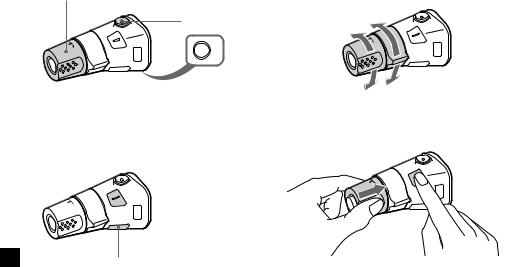
Other operations
Rotate the VOL control to
adjust the volume.
Press (ATT) to attenuate the sound.
OFF
Changing the operative direction
The operative direction of controls is factoryset as shown below.
To increase
Press (OFF) to turn off the unit.
Note
When installing in a car without ACC (accessory) position on the ignition key switch, press (OFF) for two seconds to turn off the clock display after turning off the engine.

 Press (SOUND) to adjust sound menu.
Press (SOUND) to adjust sound menu.
Press (DSPL) to change the displayed items.
Tip
While the ATA function is activated, the display (TAPE y TUNER) can be changed by pressing
(DSPL).
To decrease
If you need to mount the rotary commander on the right hand side of the steering column, you can reverse the operative direction.
Press (SOUND) for two seconds while pushing the VOL control.
Tip
You can also change the operative direction of these controls with the unit (see “Changing the sound and display settings” on page 23).
22

Adjusting the sound characteristics
You can adjust the bass, treble, balance, and fader.
You can store the bass and treble levels independently for each source.
1 Select the item you want to adjust by pressing (SOUND) repeatedly.
Each time you press (SOUND), the item changes as follows:
BAS (bass) t TRE (treble) t
BAL (left-right) t FAD (front-rear)
2 Adjust the selected item by pressing < or ,.
When adjusting with the rotary commander, press (SOUND) and rotate the VOL control.
Note
Adjust within three seconds after selecting the item.
Attenuating the sound
Press (ATT) on card remote commander or the rotary commander.
“ATT on” appears momentarily.
To restore the previous volume level, press (ATT) again.
Tip
When the interface cable of a car telephone is connected to the ATT lead, the unit decreases the volume automatically when a telephone call comes in.
Changing the sound and display settings
The following items can be set:
Set (Setting)
•Clock (page 10).
•CT (Clock Time) (page 20).
•Beep — to turn the beep sound on or off. •RM (Rotary Commander) — to change the
operative direction of the rotary commander.
—Select “norm” to use the rotary commander as the factory-set position.
—Select “rev” when you mount the rotary commander on the right side of the steering column.
•English/Spanish/Portuguese/Swedish — to change the display language to English, Spanish, Portuguese or Swedish.
Dis (Display)
•D.Info (Dual Information) — to display the clock and the play mode simultaneously (on), or to display the information alternately (off).
•SA (Spectrum Analyzer) — to change the display pattern of the equalizer display (page 25).
•Dimmer — to change the brightness of the display (When the Illumination terminal connected).
—Select “on” to dim the display.
—Select “off” to deactivate Dimmer. •Contrast — to adjust the contrast if the
indications in the display are not recognisable because of the unit’s installed position.
•M.Dspl (Motion Display) — to turn the motion display on or off.
•A.Scrl (Auto Scroll) (page 27).
continue to next page t
23

1 Press (MENU).
2 Press M or m repeatedly until the desired item appears.
Each time you press m, the item changes as follows:
Example
Clock t CT t Beep t RM t English/ Spanish/Portuguese/Swedish t D.Info t SA t Dimmer t Contrast t M.Dspl*1 t A.Scrl*2
*1 When no CD or MD is playing, this item will not appear.
*2 When the radio is off, or when no tape, CD, or MD is playing, this item will not appear.
Note
The displayed item will differ depending on the source.
Tip
You can easily switch among categories (“Set,” “Snd” (Sound), “P/M” (Play Mode) and “Dis”) by pressing M or m for two seconds.
3 Press , to select the desired setting (Example: on or off).
4 Press (ENTER).
After the mode setting is complete, the display returns to normal playback mode.
Boosting the bass sound
— D-bass
You can enjoy a clear and powerful bass sound. The D-bass function boosts the low frequency signal and high frequency signal with a sharper curve than conventional bass boost.
You can hear the bass line more clearly even while the vocal volume remains the same. You can emphasize and adjust the bass sound easily with the D-BASS button.
Level |
D-BASS 3 |
|
|
D-BASS 2 |
|
|
D-BASS 1 |
D-BASS 3 |
|
|
D-BASS 2 |
|
|
D-BASS 1 |
0dB
Frequency (Hz)
Adjusting the bass curve
Press (D-BASS) repeatedly to select the desired bass curve.
As the D-BASS number increases so does the effect.
D-BASS 1 t D-BASS 2 t D-BASS 3 t D-BASS off
Note
The bass sound may distort at same volume. If the bass sound distorts, select less effective bass curve.
24

Selecting the spectrum analyser
The sound signal level is displayed on a spectrum analyser. You can select a display pattern from 1 to 6, or the automatic display mode.
1 Press (SOURCE) to select a source (tuner, tape, CD, or MD).
2 Press (MENU).
3 Press M or m repeatedly until “SA” appears.
4 Press < or , repeatedly to select the desired setting.
B SA 1 b |
B … SA 6 b |
B SA Auto* b |
B SA off b |
*All of these display patterns appear one by one automatically.
5 Press (ENTER).
Adjusting the sound and frequency of the equalizer preamplifier
This unit can also control an optional equalizer preamplifier.
This lets you add some effects to the sound field of the currently selected source.
For details, refer to the instructions manual supplied with the equalizer preamplifier.
25

With Optional Equipment
CD/MD Unit
This unit can control external CD/MD units. If you connect an optional CD unit with the CD TEXT function and the custom file function, the CD TEXT information will appear in the display when you play a CD TEXT disc.
Playing a CD or MD
1 Press (SOURCE) repeatedly to select CD or MD.
2 Press (MODE) until the desired unit appears.
CD/MD playback starts.
When a CD/MD unit is connected, all the tracks play from the beginning.
Changing the display item
Each time you press (DSPL/PTY) during CD, CD TEXT, or MD playback, the item changes as follows:
V
Disc number/Track number/
Elapsed playing time
V
Disc name*1/Artist name*2
V
Track name*3
V
FM1 frequency*4
*1 If you have not labelled the disc or if there is no disc name prerecorded on the MD,
“NO D.Name” appears momentarily in the display.
*2 If you play a CD TEXT disc, the artist name appears in the display after the disc name. (Only for CD TEXT discs with the artist name.)
*3 If the track name of a CD TEXT disc or MD is not prerecorded, “NO T.Name” appears momentarily in the display.
*4 While the AF/TA function is activated.
After you select the desired item, the display will automatically change to the Motion Display mode after a few seconds.
In the Motion Display mode, all the items are scrolled in the display one by one in order.
Tip
The Motion Display mode can be turned off. (See “Changing the sound and display settings” on page 23.)
26

Automatically scrolling a disc name
— Auto Scroll
If the disc name, artist name, or track name on a CD TEXT disc or MD exceeds 10 characters and the Auto Scroll function is on, information automatically scrolls across the display as follows:
•The disc name appears when the disc has changed (if the disc name is selected).
•The track name appears when the track has changed (if the track name is selected).
If you press (DSPL/PTY) to change the display item, the disc or track name of the MD or CD TEXT disc is scrolled automatically whether you set the function on or off.
1 During playback, press (MENU).
2 Press M or m repeatedly until “A.Scrl” appears.
3 Press , to select “A.Scrl on.”
4 Press (ENTER).
To cancel Auto Scroll, select “A.Scrl off” in step 3.
Note
For some discs with very many characters, the following cases may happen:
—Some of the characters are not displayed
—Auto Scroll does not work.
Locating a specific track
—Automatic Music Sensor (AMS)
During playback, press < or , momentarily for each track you want to skip.
< (.) : To locate preceding tracks
, (>) : To locate succeeding tracks
Locating a specific point in a track
—Manual Search
During playback, press and hold < or ,. Release when you have found the desired point.
< (m) : To search forward , (M) : To search backward
Switching to other discs
During playback, press M or m.
The desired disc in the current unit begins playback.
M (DISC +) : For succeeding discs m (DISC –) : For preceding discs
Track number
Disc number |
Elapsed playback time |
27

Playing tracks repeatedly
— Repeat Play
You can select:
•Repeat 1 – to repeat a track. •Repeat 2 – to repeat a disc.
1 During playback, press (MENU).
2 Press M or m repeatedly until “Repeat” appears.
3 Press , repeatedly until the desired setting appears in the display.
B Repeat 1 B Repeat 2
Repeat off b
Repeat Play starts.
To return to normal play mode, select “Repeat off” in step 3.
Tip
If you select the mode using the buttons on the unit, press (1) (REP) repeatedly until the desired mode appears.
Playing tracks in random
order — Shuffle Play
You can select:
•Shuf 1 – to play the tracks on the current disc in random order.
•Shuf 2 – to play the tracks in the current unit in random order.
•Shuf All* – to play all the tracks in all the units in random order.
1 During playback, press (MENU).
2 Press M or m repeatedly until “Shuf” appears.
3 Press , repeatedly until the desired setting appears in the display.
B Shuf 1 |
B Shuf 2 |
B Shuf All* |
Shuf off b
Shuffle Play starts.
*“Shuf All” is only available when you connect two or more optinal CD/MD units.
To return to normal play mode, select “Shuf off” in step 3.
Tip
If you select the mode using the buttons on the unit, press (2) (SHUF) repeatedly until the desired mode appears.
28
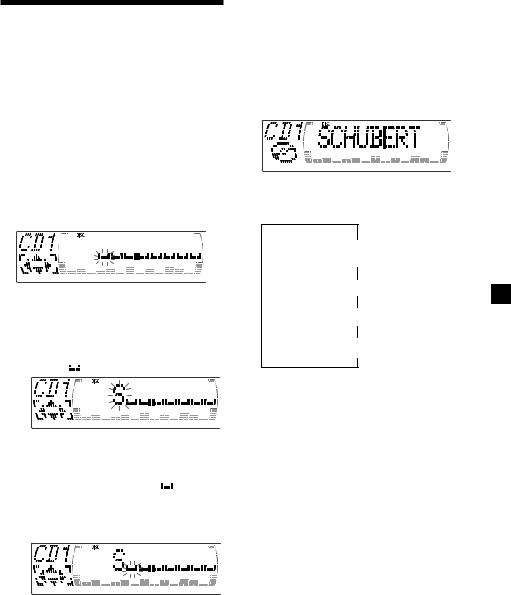
Labelling a CD — Disc Memo
(For a CD unit with the custom file function)
You can label each disc with a personalised name. You can enter up to eight characters for a disc. If you label a CD, you can locate the disc by name (page 30) and select the specific tracks for playback (page 31).
1 Start playing the disc you want to label.
2 Press (MENU), then press M or m repeatedly until ”Name Edit” appears.
3 Press (ENTER).
Name edit mode
4 Enter the characters.
1Press M repeatedly to select the desired characters.
(A t B t C t ··· Z t 0 t 1 t 2 t
··· 9 t + t – t * t / t \ t > t <
t . t )
If you press m repeatedly, the characters will appear in reverse order.
If you want to put a blank space between characters, select “ .”
2Press , after locating the desired character.
The next character flashes.
If you press < , the previous character flashes.
3Repeat steps 1 and 2 to enter the entire name.
5 To return to normal CD play mode, press
(ENTER).
Tip
There is another way to start labelling a CD. Press (LIST) for two seconds instead of steps 2 and 3. You can also complete the operation by pressing (LIST) for two seconds instead of step 5.
Displaying the disc memo
Press (DSPL/PTY) during CD or CD TEXT disc playback.
Each time you press (DSPL/PTY) during CD or CD TEXT disc playback, the item changes as follows:
V
Disc number/Track number/
Elapsed playing time
V
Disc memo name
V
Track name*1
V
FM1 frequency*2
*1 If you connect an optional CD unit with the CD TEXT function, the CD TEXT information will appear in the display when you play a CD TEXT disc.
*2 While the AF/TA function is activated.
29

Erasing the disc memo
1 Press (SOURCE) repeatedly to select “CD.“
2 Press (MODE) repeatedly to select the CD unit with the custom file function.
3 Press (MENU), then press M or m repeatedly until “Name Del” appears.
4 Press (ENTER).
5 Press M or m repeatedly to select the disc name you want to erase.
6 Press (ENTER) for two seconds.
The name is erased.
Repeat steps 5 and 6 if you want to erase other names.
7 Press (MENU) twice.
The unit returns to normal CD play mode.
Notes
•When a personalised label is erased, the original CD TEXT information will appear in the display.
•When you erase all of the disc names, “No Data” appears in step 6.
Locating a disc by name
— List-up (For a CD unit with the custom file function or an MD unit)
You can use this function for discs that have been assigned a custom name. For more information on disc memo names, refer to “Labelling a CD” (page 29).
1 Press (LIST).
The name assigned to the current disc appears in the display.
When you assign a disc memo name to a CD TEXT disc, it takes priority over the original CD TEXT information.
2 Press M (DISC +) or m (DISC –) repeatedly until you find the desired disc.
3 Press (ENTER) to play the disc.
Notes
•The track names are not displayed during MD or CD TEXT disc playback.
•If there are no discs in the magazine, “NO Disc” appears in the display.
•If a disc has not been assigned a custom file, “********” appears in the display.
•If the disc information has not been read by the unit, “?” appears in the display. To load a disc, first press the number button, then choose the disc that has not been loaded.
•Some letters cannot be displayed during MD or CD TEXT disc playback.
30
